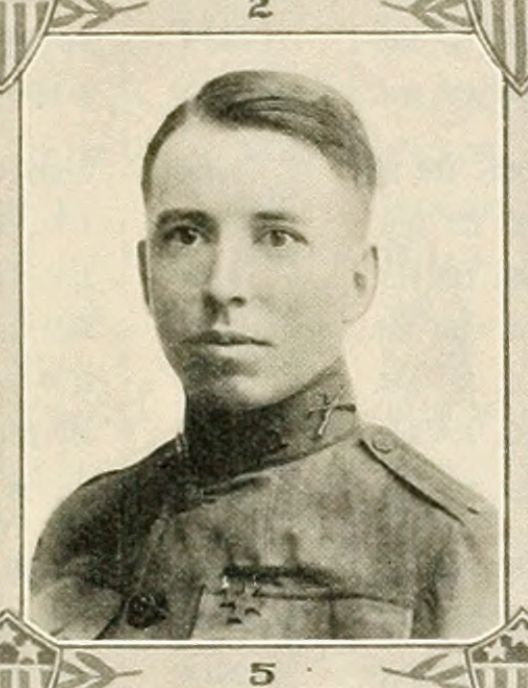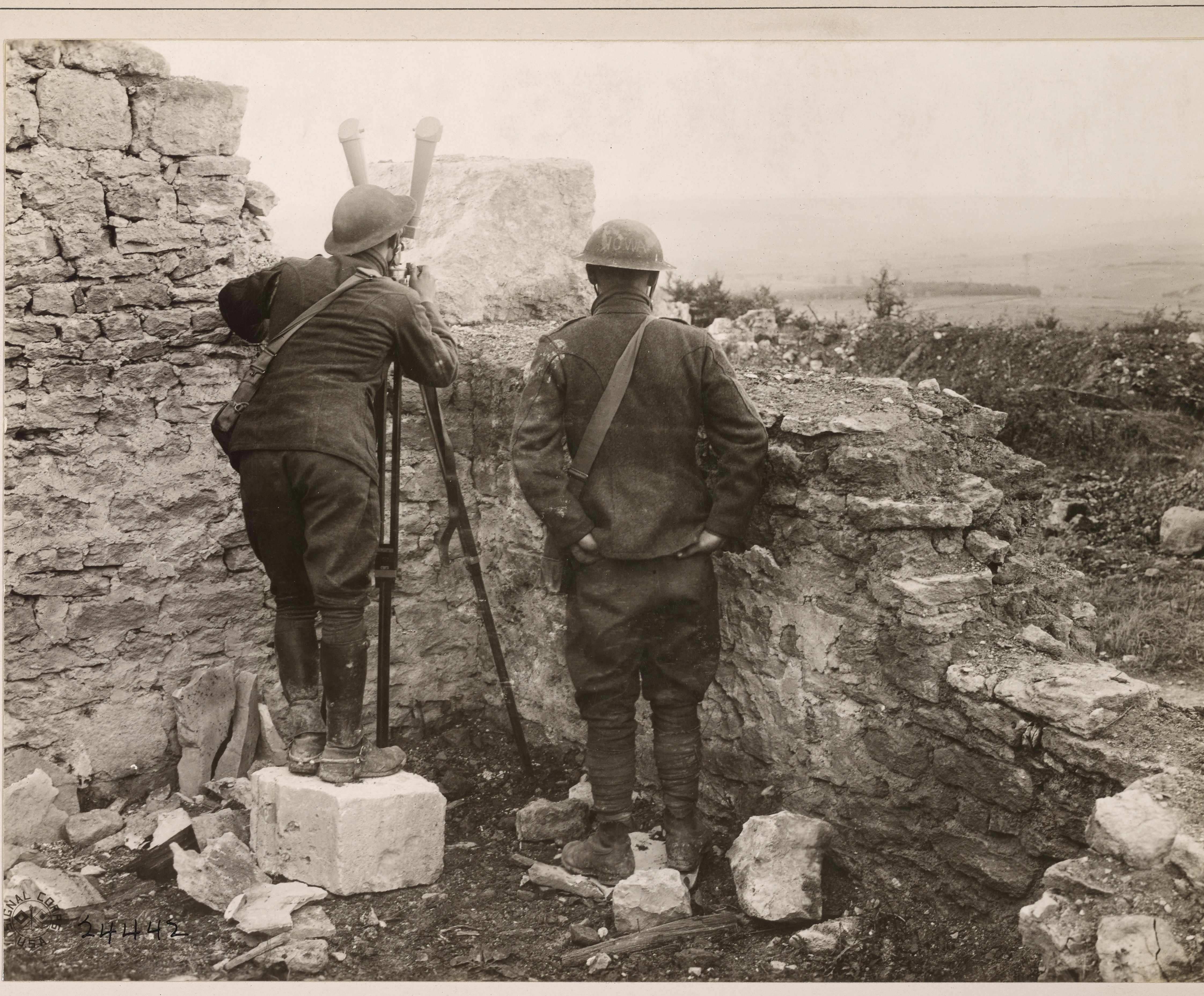Major George E. Sperbeck

- Unit: 41st Division, 147th Artillery Regiment, 2nd Battalion
- Date of Birth: November 30, 1887
- Entered the Military: November 30, 1915
- Date of Death: October 11, 1918
- Hometown: Parker, South Dakota
- Place of Death: near Gesnes, France
- Cemetery: Plot E, Row 42, Grave 14. Meuse-Argonne American Cemetery, Romagne-sous-Montfaucon, France
Chamberlain High School
2018-2019
Early Life
George E. Sperbeck was born in Milwaukee, Wisconsin on November 30, 1887. The administration of Oshkosh (Wisconsin) Normal School remembered George as a student of high character and studious by nature. After graduation, George’s name was at the top of the list for a teaching position at Fort Pierre, South Dakota.
Beginning his education career, Sperbeck moved to Fort Pierre, South Dakota where he taught and later became the principal of Fort Pierre schools. Sperbeck made South Dakota his home and joined the South Dakota National Guard.
On February 25, 1910, Sperbeck married Lucinda May Ostendorf in Pennington County, South Dakota. The couple continued to live in the Fort Pierre area, where they welcomed their first child, Winnifred, in October 1910. The Sperbecks moved to Parker, South Dakota where George took on the position of superintendent of schools. Two more children completed the Sperbeck family, Frederick, born in July 1915, and Eunice, born in December 1917.
Military Experience
In 1916, Sperbeck resigned from his position as superintendent of the Parker School District to serve with the South Dakota National Guard along the Mexican-American border. Despite his resignation, the school board of Parker held Sperbeck’s position for him until he returned.
While along the Mexican border, Sperbeck, along with the members of the South Dakota National Guard Company D, stood guard for a possible Mexican invasion by Pancho Villa. However, no such attack occurred and the South Dakota National Guard returned home in March 1917.
In April 1917, the United States entered World War I, siding with the Allied Powers. In September, Sperbeck was called again for duty. He trained in Charlotte, North Carolina, where the South Dakota National Guard merged with the 147th Field Artillery Regiment. After training, his unit traveled to Newport News, Virginia order to make the trip across the Atlantic Ocean. While in France, Sperbeck rose to the rank of captain and later to the rank of major.
Sperbeck’s unit arrived in Europe in January 1918 and reported for duty along the Alsace front with the 32nd Division. In late August or early September 1918, Captain Sperbeck, commanding Battery E, was stationed near the Valpriez Farm in the Soissons front. Sperbeck situated himself into an excellent observational post. He had access to a telephone line running to his battery as well as a comfortable foxhole. He was a “great annoyance to the Germans,” who tried to shell him out but were unable to do so. Sperbeck, an avid hunter back in South Dakota, declared that he had more fun at Valpriez Farm than he had ever enjoyed shooting ducks on the pond back home.
By October 1918, Major Sperbeck commanded the 2nd Battalion of the 147th Field Artillery. On October 9, 1918 along the front of the Kriemhilde Stellung (part of the Hindenburg line), Brigadier General George Irwin of the 32nd Infantry Division ordered one of the battalion commanders to investigate the battery positions of the Germans northwest of Gesnes, France. Sperbeck led the reconnaissance.
Sperbeck was accompanied by the executive officers of his batteries, First Lieutenant Vincent Knewel and First Lieutenant Fred Steece. As the men advanced, they faced gunfire. The three officers stopped to discuss the location of a new battery position. Unknown to them, on a hillside, was a German machine gun nest. A German soldier, who appeared dead, lay out in the open. The men continued to talk when the “dead” German opened fire with his rifle.
He struck Sperbeck in the abdomen with an explosive bullet, which burst beneath the skin near his spine. When Sperbeck fell, Knewel ran to the machine gun nest, and upon finding a loaded rifle, fired at the German. Sperbeck cried out, “Let me get him!” and fired his pistol twice, but missed. Knewel fired again, this time killing the German soldier.
Both Knewel and Steece started back for Sperbeck, when he called to them to stay where they were. Unaided, Sperbeck rolled himself over and into a pit. Knowing that Sperbeck was suffering, Knewel ran towards Gesnes, jumping in and out of trenches to escape the German machine guns. He reached a dressing station of the 126th Infantry Regiment, procured stretcher bearers, led them back to Major Sperbeck. The men were shot at, but returned to Sperbeck’s location. He was placed on the stretcher and the party returned to the dressing station without incident. Sperbeck was placed in an ambulance and transported to a field hospital near Very, France. As Sperbeck’s wound was inflicted by an incendiary bullet, his wound proved fatal. Major Sperbeck died two days later, on October 11, 1918.


Photograph of the 313th Field Artillery moving to new positions through the town of Tailly, Ardennes, France, November 4, 1918. National Archives and Records Administration (111-SC-031487-ac).

Temporary graves located near an advanced dressing station near Juvigny, France, September 1, 1918.
National Archives and Records Administration (111-SC-21913-ac).
Eulogy
Upon hearing of the Sperbeck’s death, many members of the 147th Artillery Regiment came back from the front to pay their respects to their comrade. To honor Sperbeck, they made a rude coffin of finished boards they found and held a burial service. The men of Battery E, most of whom were from Major Sperbeck’s hometown, erected a large cross with a name plate made from a brass shell.
When Lucinda Sperbeck received word of her husband’s death, she also received a letter from fellow South Dakotan, Lieutenant Howard Warren, a soldier who served with her husband. In his letter, Warren expressed the thoughts of many of the soldiers that served with Sperbeck, “he was one of the most fearless and one of the most capable officers it has been my pleasure to meet…You will find it is the universal feeling in this regiment that a more fearless and honorable man never served in the United States army [sic] than your husband.”
Mrs. Sperbeck wished at first to bring her husband home for his final resting place, but plans changed. Major George E. Sperbeck was buried at Meuse-Argonne American Cemetery in Romagne-sous-Montfaucon, France.
The American Legion post in Parker, South Dakota, is named the George E. Sperbeck, South Dakota Post 30.


Photograph of George E. Sperbeck’s grave at Meuse-Argonne American Cemetery in Romagne-sous-Montfaucon, France,
June 24, 2019. Courtesy of Carissa VanderLey.Reflection
Bibliography
41st Division; Records of Combat Divisions, 1918-1919, Records of the American Expeditionary Forces (World War I), Record Group 120 (Box 5); National Archives at College Park, College Park, MD.
147th Field Artillery Regiment, Headquarters; World War I Organizational Records, Record Group 120 (Box 1200); National Archives at College Park, College Park, MD.
147th – 148th Infantry Regiments; World War I Strength Returns, Records of the Adjutant General’s Office, Record Group 407 (Box 207); National Archives at College Park, College Park, MD.
Cloud, Lieutenant P W. The 313th Field Artillery moving up to new positions through the town of Tailly, Ardennes, France. Photograph. November 4, 1918. National Archives and Records Administration (111-SC-031487-ac). Image.
“George E. Sperbeck.” American Battle Monuments Commission. Accessed January 10, 2019. www.abmc.gov/node/335010
George E. Sperbeck, Official Military Personnel File, Department of the Army, RG 319, National Archives and Records Administration – St. Louis.George E. Sperbeck World War I Burial Case File and Pay Records; Correspondence, Reports, Telegrams, Applications and Other Papers relating to Burials of Service Personnel, Records of the Quartermaster General’s Office, 1915-1935, Record Group 92; National Archives and Records Administration – St. Louis.
George E. Sperbeck World War I Burial Case File and Pay Records; Correspondence, Reports, Telegrams, Applications and Other Papers relating to Burials of Service Personnel, Records of the Quartermaster General’s Office, 1915-1935, Record Group 92; National Archives and Records Administration – St. Louis.
Gillette, Mary Murphy. “”A Small War in a Beer-Drinking Country”: The South Dakota National Guard on the Mexican Border.” South Dakota History 16, no. 1 (Spring 1986): 35-66. Accessed March 2, 2019. www.sdhspress.com/journal/south-dakota-history-16-1/a-small-war-in-a-beer-drinking-country-the-south-dakota-national-guard-on-the-mexican-border/vol-16-no-1-a-small-war-in-a-beer-drinking-country.pdf.
Hanson, Corporal Allen. Advanced Dressing Station, the farthest point…near Juvigny, France. Photograph. September 1, 1918. National Archives and Records Administration (111-SC-21913-ac). Image.
Hanson, Joseph Mills. South Dakota in the World War 1917-1919. Pierre: South Dakota State Historical Society, 1940.
Record of Service of 147th Field Artillery (Formerly Fourth Infantry, S.D.N.G) In France to 11th November 1918.South Dakota State University. Accessed August 19, 2019. openprairie.sdstate.edu/cgi/viewcontent.cgi?referer=https://www.google.com/&httpsredir=1&article=1006&context=archives_rare-books
“School News.” South Dakota Educator, 32, no. 4 (December 1918): 13. books.google.com/books?id=Zn5JAQAAMAAJ&pg=RA2-PA13&dq=major+george+e+sperbeck&hl=en&sa=X&ved=0ahUKEwik0qPUl6niAhUQeKwKHcgqBjwQ6AEIJzAA#v=onepage&q=major%20george%20e%20sperbeck&f=false
South Dakota. 1915 State Census. Digital Images. ancestry.com.
Stone, Lieutenant Charles. Looking due East over Bois de Septarges, captured….Montfaucon, Meuse, France. Photograph. October 1, 1918. National Archives and Records Administration (111-SC-24442-ac). Image.
U.S. Army Transport Service, Passenger Lists, 1910-1939. Digital Images. ancestry.com.

